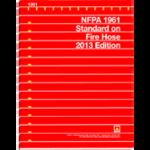NFPA (Fire) 1961
Click here to purchase
Fire hoses play a vital role in controlling and extinguishing fires. Update to the 2013 NFPA 1961 to maximize equipment performance.
NFPA 1961: Standard on Fire Hose presents the minimum requirements for the design and construction of new fire hose, the testing required to verify the design and construction, and the inspection and testing required of all new fire hose.
This important document for fire hose manufacturers and the fire service applies to:
- Attack hose used by trained firefighters and fire brigade members in regular fire fighting operations
- Occupant use hose typically provided on standpipe systems for untrained building occupants to use
- Forestry hose used in wildland fire suppression
- Supply hose (large diameter hose) used to convey water from its source to fire apparatus at a fire scene
- Suction hose used to get water into a pump when the water must be pumped from a static source such as a lake or river
Fire hose reliability starts with the 2013 NFPA 1961. Order the today and make sure you’re working with the latest rules!
Revisions in the 2013 edition include a change in the maximum weight of a lined, synthetic woven reinforcement forestry fire hose assembly and new definitions for Design Service Test Pressure and Service Test Pressure.
Product Details
- Published:
- 06/18/2012
- ISBN(s):
- 9781455904501
- Number of Pages:
- 23
NFPA (Fire) 1961
Click here to purchase
NFPA 1961 shall define the design and construction requirements for new fire hose, the testing required to verify the design and construction, and the inspection and testing required of all new fire hose.
All fire hose has an expected service life. That life will depend on a number of factors, such as the initial quality of the hose, the type of service to which it is subjected, and the care it receives during its life. Users should develop a fire hose inspection and care program based on NFPA1962, Standard for the Inspection, Care, and Use of Fire Hose, Couplings, and Nozzles and the Service Testing of Fire Hose. That program should also address the retirement of fire hose. One of the reasons for keeping good records of fire hose as required by NFPA 1962 is to evaluate how different fire hoses perform over time. This will provide the experience the users need to help them determine what a useful service life is for different types of hose and make decisions on when fire hose should be retired. Limited testing of in-service fire hose by the Fire Equipment Manufacturers Association indicated an increased risk of failure after a 10-year time period. The testing looked at the reduction in burst pressure, ozone degradation, liner adhesion and degradation, hose strength, normal wear patterns, and UV degradation of fibers. While all users should establish their own retirement schedule, fire departments should give careful consideration to a 10-year maximum service life under normal operating conditions.
Product Details
- Published:
- 01/01/2020
- ISBN(s):
- 9781455923557
- Number of Pages:
- 26

